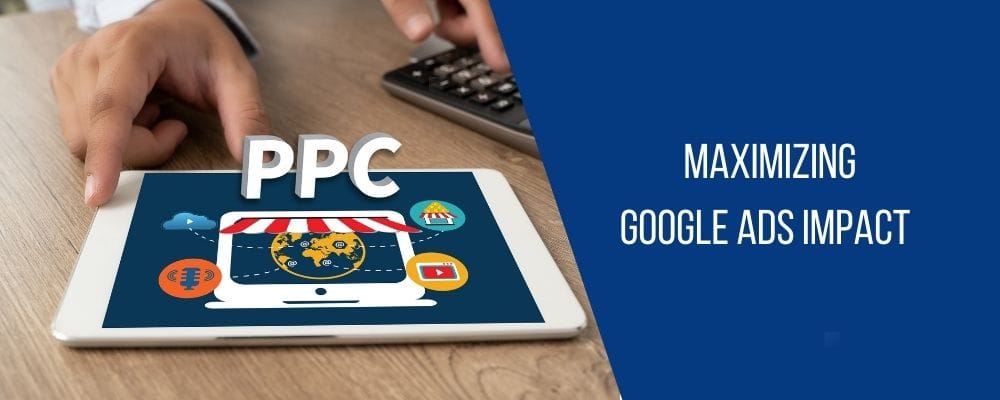Google Ads offers a powerful platform to drive traffic, generate leads, and boost revenue. However, with increasing competition, it’s essential to implement the right strategies to truly maximize your Google Ads impact. In this article, we’ll explore 10 proven strategies that can help you enhance your Google Ads performance and increase the overall effectiveness of your campaigns.

1. Optimize for Keyword Intent for Maximum Google Ads Impact
Keyword intent is crucial to maximizing Google Ads’ impact. Instead of targeting generic keywords, focus on intent-based keywords that align with your potential customers’ needs. For example, instead of broad keywords like “running shoes,” target phrases such as “buy running shoes online” or “best running shoes for marathon.” This helps ensure that your ads reach people who are ready to convert, improving your overall ad impact.
2. Long-Tail Keywords
While high-traffic, short-tail keywords are tempting, long-tail keywords often result in higher conversion rates. These specific search phrases have lower competition and can generate more qualified leads. Incorporate long-tail keywords into your ad copy and landing pages to attract users with clear purchasing intent.
3. Use Negative Keywords
Negative keywords help ensure that your ads are not shown to unlikely convert users. By filtering out irrelevant traffic, you can reduce wasted ad spend and improve your Google Ads campaign efficiency. For example, if you sell luxury watches, you may want to add negative keywords like “cheap watches” to avoid attracting budget shoppers.
4. Craft Compelling Ad Copy
Your ad copy is your first interaction with potential customers, so it needs to be engaging and persuasive. Highlight your product or service’s unique selling propositions (USPs) and include a clear call to action (CTA). Use power words like “exclusive,” “limited-time offer,” or “guaranteed” to create urgency. A/B testing your ad copy can help you determine what resonates most with your audience.
5. Implement Ad Extensions
Ad extensions can dramatically increase your Google Ads visibility by providing additional information without increasing costs. Extensions like site links, callouts, and location extensions offer more opportunities for users to engage with your ad. For instance, a callout extension can highlight free shipping, while a site link can direct users to specific pages like your “About Us” or “Pricing” page.
6. Optimize Landing Pages
A well-optimized landing page is vital to improving conversion rates. Ensure that your landing page matches the intent of your ads. Use clear headlines, concise content, and a strong CTA to guide users through the conversion process. Speed is also essential—if your landing page takes too long to load, users are likely to bounce, wasting your ad spend.
7. Utilize Remarketing Campaigns
Remarketing allows you to target users who have already interacted with your website but didn’t convert. By displaying relevant ads to these users, you keep your brand top of mind and encourage them to return to complete their purchase. You can create dynamic remarketing ads that showcase specific products or services users have viewed, increasing the likelihood of conversion.
8. Test Different Ad Formats
Google Ads offers a variety of ad formats, including search ads, display ads, shopping ads, and video ads. Experimenting with different formats can help you discover what works best for your business. For example, video ads might perform better for visually driven products, while shopping ads are ideal for e-commerce businesses looking to showcase specific products.
9. Set Up Conversion Tracking
Conversion tracking is critical for understanding the true impact of your Google Ads campaigns. It helps you measure actions like purchases, form submissions, or phone calls. By setting up conversion tracking, you can monitor which ads are driving the most conversions and adjust your strategy accordingly. This ensures that you’re only investing in ads that provide value.
10. Continuously Monitor and Optimize Performance for maximum Google Ads Impact
The key to long-term success with Google Ads is continuous optimization. Regularly monitor metrics like click-through rates (CTR), conversion rates, and cost per acquisition (CPA). Make data-driven adjustments to your bids, keywords, and targeting to improve performance over time. Automation tools like Google’s Smart Bidding can also help optimize your bids for maximum conversion value.
Conclusion
Maximizing the impact of your Google Ads campaigns requires a combination of strategic planning, optimization, and continuous testing. By implementing these 10 proven strategies, you can enhance your ad performance, reduce wasted spend, and ultimately drive more conversions. Whether you’re optimizing for keywords, refining your ad copy, or experimenting with different ad formats, these strategies will help you achieve success with Google Ads.
Frequently Asked Questions (FAQ)
What are negative keywords, and why are they important?
Negative keywords are search terms that prevent your ads from being shown for irrelevant queries. They help you avoid wasting money on clicks from users who are unlikely to convert, improving your overall ad efficiency.
How can long-tail keywords benefit my Google Ads campaign?
Long-tail keywords are more specific and often have lower competition than short-tail keywords. They tend to attract more qualified leads and result in higher conversion rates, as users searching for these terms are typically closer to making a purchase decision.
Why is remarketing important in Google Ads?
Remarketing allows you to re-engage users who have already visited your website but didn’t convert. It keeps your brand in front of these users, increasing the likelihood of them returning to complete a purchase or take another desired action.
How does conversion tracking improve campaign performance?
Conversion tracking helps you measure the actions users take after clicking your ad, such as making a purchase or signing up for a newsletter. This data is crucial for understanding which ads are driving valuable results, allowing you to allocate your budget more effectively.
What is A/B testing, and how does it help my ad campaigns?
A/B testing involves creating different versions of your ads and testing them to see which performs better. It allows you to fine-tune your ad copy, visuals, and CTAs to maximize effectiveness and improve conversion rates over time.


